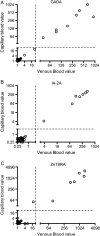Capillary blood islet autoantibody screening for identifying pre-type 1 diabetes in the general population: design and initial results of the Fr1da study
- PMID: 27194320
- PMCID: PMC4874167
- DOI: 10.1136/bmjopen-2016-011144
Capillary blood islet autoantibody screening for identifying pre-type 1 diabetes in the general population: design and initial results of the Fr1da study
Abstract
Introduction: Type 1 diabetes can be diagnosed at an early presymptomatic stage by the detection of islet autoantibodies. The Fr1da study aims to assess whether early staging of type 1 diabetes (1) is feasible at a population-based level, (2) prevents severe metabolic decompensation observed at the clinical manifestation of type 1 diabetes and (3) reduces psychological distress through preventive teaching and care.
Methods and analysis: Children aged 2-5 years in Bavaria, Germany, will be tested for the presence of multiple islet autoantibodies. Between February 2015 and December 2016, 100 000 children will be screened by primary care paediatricians. Islet autoantibodies are measured in capillary blood samples using a multiplex three-screen ELISA. Samples with ELISA results >97.5th centile are retested using reference radiobinding assays. A venous blood sample is also obtained to confirm the autoantibody status of children with at least two autoantibodies. Children with confirmed multiple islet autoantibodies are diagnosed with pre-type 1 diabetes. These children and their parents are invited to participate in an education and counselling programme at a local diabetes centre. Depression and anxiety, and burden of early diagnosis are also assessed.
Results: Of the 1027 Bavarian paediatricians, 39.3% are participating in the study. Overall, 26 760 children have been screened between February 2015 and November 2015. Capillary blood collection was sufficient in volume for islet autoantibody detection in 99.46% of the children. The remaining 0.54% had insufficient blood volume collected. Of the 26 760 capillary samples tested, 0.39% were positive for at least two islet autoantibodies.
Discussion: Staging for early type 1 diabetes within a public health setting appears to be feasible. The study may set new standards for the early diagnosis of type 1 diabetes and education.
Ethics dissemination: The study was approved by the ethics committee of Technische Universität München (Nr. 70/14).
Keywords: childhood; islet autoantibodies; screening; type 1 diabetes.
Published by the BMJ Publishing Group Limited. For permission to use (where not already granted under a licence) please go to http://www.bmj.com/company/products-services/rights-and-licensing/
Figures





References
-
- IDF Diabetes Atlas, 6th edition. https://www.idf.org/sites/default/files/EN_6E_Atlas_Full_0.pdf.
-
- Ehehalt S, Dietz K, Willasch AM et al. , DIARY-Group Baden-Wuerttemberg. Prediction model for the incidence and prevalence of type 1 diabetes in childhood and adolescence: evidence for a cohort-dependent increase within the next two decades in Germany. Paediatr Diabetes 2012;13:15–20. 10.1111/j.1399-5448.2011.00799.x - DOI - PubMed
Publication types
MeSH terms
Substances
LinkOut - more resources
Full Text Sources
Other Literature Sources
Medical
